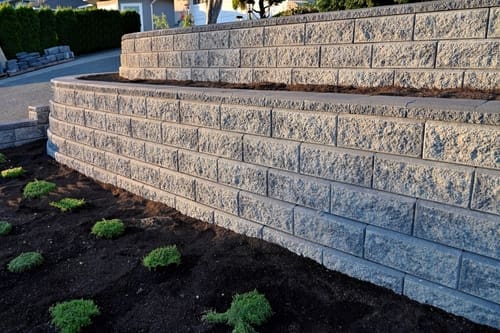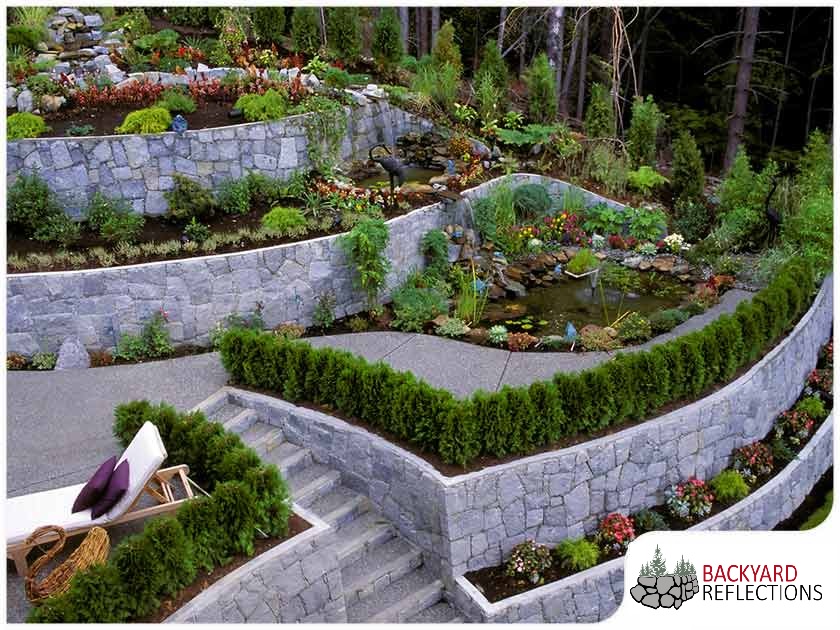Expert tips for maintaining OKC Precision Retaining Walls year-round
Expert tips for maintaining OKC Precision Retaining Walls year-round
Blog Article
Secret Considerations for Structure Efficient Retaining Walls in Your Backyard
When you're considering constructing a maintaining wall surface in your lawn, it's crucial to think regarding numerous essential variables. The wall's objective, the materials you'll make use of, and the particular dirt conditions can all affect its performance and durability.
Understanding the Objective of Your Retaining Wall
When you consider building a maintaining wall surface, consider its main function: supporting dirt and stopping disintegration. Retaining walls offer crucial support for sloped landscapes, helping to preserve dirt honesty. You'll find they're important in locations where water drainage might or else remove soil, leading to expensive fixings and landscape damages.
By holding back planet, these walls create degree surface areas for yards, patio areas, or pathways. This not only improves your lawn's aesthetic appeals yet additionally advertises better drain, decreasing water pooling in undesirable locations. If you're handling high inclines, a sound retaining wall surface can stop landslides, ensuring security for you and your residential property.
Inevitably, understanding the purpose of your retaining wall will guide your design choices and help you create a functional, durable framework that fulfills your demands. So, take a minute to examine your landscape; it'll settle in the future.
Picking the Right Products
When choosing materials for your retaining wall surface, you'll desire to take into consideration durability, aesthetic appeals, and expense. Each factor plays a vital function in ensuring your wall surface stands the test of time while looking terrific and fitting your budget. Allow's discover exactly how to make the finest choices for your task.
Product Sturdiness Elements
Picking the right products is important for the longevity and effectiveness of your retaining wall surface, because their sturdiness directly influences the wall's ability to stand up to environmental stress and anxieties. Begin by considering your local climate; products like concrete and rock withstand moisture and temperature level fluctuations well. If you stay in an area prone to hefty rainfalls, go with products with great water drainage residential or commercial properties, like crushed rock or permeable blocks, to stop water accumulation.
Some materials carry out better in certain soil types, so it's important to match them accordingly. Selecting durable products assurances your retaining wall surface stands solid, securing your backyard for years to come.
Visual Style Options
Durable materials not just guarantee your retaining wall surface's structural honesty yet also play a key function in its visual charm. When selecting the ideal products, assume concerning how they match your landscape. Natural stone provides an ageless, rustic look, while concrete blocks can offer a streamlined, modern-day finish. You might also consider using timber for a warm, natural feel. Color and texture matter, too; pick tones that integrate with your home and garden. Don't forget the wall surface's form-- rounded walls can produce a softer look, while straight lines can feel extra structured. By meticulously picking materials that line up with your visual vision, you'll improve your outside area while guaranteeing your wall stands strong versus the elements.
Cost-Effectiveness Evaluation
Selecting the right products for your retaining wall surface isn't simply concerning looks; it's also vital for your spending plan. When selecting products, take into consideration both upfront expenses and long-lasting durability. For example, concrete blocks might be pricier initially, however their longevity can save you money on repair services. On the other hand, wood can be a lot more affordable but might require replacement faster.
Don't forget to aspect in upkeep prices also (OKC Precision Retaining Walls). Some products, like natural stone, can add appeal and require less upkeep, while others may need normal treatments
Inevitably, consider the advantages and disadvantages of each alternative against your spending plan and the wall surface's desired objective. Spending intelligently in products currently can stop pricey concerns later on. Pick products that balance expense and performance successfully.
Analyzing Dirt Problems and Drain
As you begin your project, reviewing dirt conditions and water drainage is necessary for the success of your retaining wall. Sandy soil drains pipes well however lacks security, while clay soil can retain dampness, leading to push on your wall surface.
Next, analyze the slope of your yard. If water normally flows towards your wall surface, you'll need to apply a drain service to protect against disintegration and pressure accumulation. Take into consideration mounting perforated pipes or crushed rock backfill behind the wall surface to help with drain.
Finally, observe any neighboring trees or plants; their roots can impact soil stability. By understanding your dirt conditions and applying proper drainage, you'll develop a strong structure for your retaining wall surface that stands the test of time.
Following Local Building Codes
Before you start developing your retaining wall, you require to research local policies to ensure conformity. It's vital to understand what permits you need to get, as this can save you from expensive penalties or having to renovate your job. Taking these actions seriously will help you build a secure and effective framework.
Study Local Rules
Understanding local policies is vital when preparing your retaining wall job, particularly considering that constructing codes can differ considerably by area. Beginning by contacting your local building division or district to discover certain demands. Try to find guidelines on wall surface elevation, materials, drain systems, and structural honesty. Several areas have restrictions on the types of products you can make use of and exactly how high you can build. You'll also desire to take into consideration the zoning regulations that visit their website may impact your project. Ignoring these laws can cause expensive fines or the demand to remodel your work. By doing your research upfront, you can assure your retaining wall meets all needed codes and blends perfectly into your backyard.
Obtain Necessary Permits
As soon as you have actually investigated neighborhood regulations, the next action is to get the essential licenses for your retaining wall surface task. This procedure warranties your wall abides by building regulations and security criteria. Reach out to your regional structure authority to discover what permits you require. They may call for specific plans or design analyses, especially for larger walls. Be prepared to send detailed illustrations, consisting of dimensions and materials. Don't fail to remember to examine if your project affects drain or bordering properties, as these elements may call for added permits. Securing the best authorizations can save you from costly fines or having to dismantle your wall surface later on. Bear in mind, adhering to the regulations now will result in a smoother building and construction experience.

Preparation the Layout and Aesthetics
As you begin intending the layout and visual appeals of your retaining wall, consider how it will balance with the surrounding landscape. Think regarding the products you'll utilize-- rock, block, or concrete-- and just how they'll match your home's style and the all-natural elements in your lawn. Choose shades and appearances that blend perfectly with existing features like patio areas, paths, or yards.
Next, envision the wall surface's shape and elevation. Curved walls can soften an inflexible landscape, while straight lines may share a much more contemporary look. Do not fail to remember to incorporate plants and plant around the wall for an all-natural touch; this can boost its charm and incorporate it right into the environment.
Lastly, keep in mind capability. Your style needs to not just be visually pleasing however additionally offer its objective successfully. By attentively preparing these components, you'll create a retaining wall that boosts your lawn's elegance while fulfilling its architectural duty.
Calculating Elevation and Density Requirements
To build a durable retaining wall surface, you need to precisely compute its height and thickness demands based upon the dirt conditions and the elevation of the incline it will certainly support. Begin by reviewing the slope's angle and the sort of soil, as various dirts exert varying amounts of stress.
For walls over 4 feet high, consider a thickness of at least 12 inches. If the wall is taller, boost the thickness proportionally to maintain stability.
Following, compute the elevation of the wall surface by gauging the vertical distance it needs to keep. For every single foot of elevation, you need to usually prepare for a density of one-third of the wall surface's elevation.
Constantly remember to account for additional elements like drain and backfill, which can influence your wall surface's style. Proper calculations now assure your retaining wall stands solid and lasts for years to find.
Upkeep and Long Life Factors To Consider
While keeping your retaining wall might seem like a low top priority, ignoring it can result in considerable problems in time. Routine assessments are crucial; look for splits, protrudes, or any type of indicators of water damage. Attending to these issues early can save you from costly repairs down the road.
Keep an eye on drainage systems, too. Clogged drains can create water to accumulate, applying pressure on your wall surface and endangering its stability. Clear debris and guarantee appropriate flow to keep long life.
You may additionally wish to show on sealing your wall to shield it from wetness and weathering. Depending upon the material, this could need reapplication every few years.
Last but not least, landscape design around your wall can sustain its integrity. Stay clear of growing large trees close by, as their roots can threaten the foundation. With aggressive maintenance, your retaining wall surface can serve you well for several years ahead.

Often Asked Inquiries
Can I Develop a Retaining Wall by Myself, or Should I Work with a Specialist?
You can most definitely build a retaining wall yourself if you have the right tools and expertise. However, employing a professional warranties it's done correctly, especially i was reading this for bigger or even more complicated frameworks. Consider your skill degree before determining.
What Are one of the most Common Blunders Made When Building Retaining Walls?
When developing retaining walls, you could ignore proper drainage, skip using the right materials, or overlook reinforcement. These usual blunders can lead to see this page architectural failure, so take your time and strategy meticulously to prevent problems.
Just how Do I Know if My Retaining Wall Requirements Support?
You'll recognize your retaining wall requires support if you discover splits, leaning, or bulging. Check for water pooling behind it or dirt erosion near the base. Address these indicators without delay to avoid additional damage.
What Plants Appropriate for Landscaping Around a Retaining Wall?
When landscape design around a keeping wall, consider making use of low-maintenance plants like succulents, ornamental turfs, or slipping ground covers - OKC Precision Retaining Walls. They'll thrive in those problems and add appeal while avoiding dirt erosion around your wall
How Can I Stop Erosion Around My Retaining Wall?
To stop erosion around your retaining wall surface, you can plant ground cover, use mulch, and mount drain systems. On a regular basis check for water accumulation and readjust landscaping to reroute drainage away from the wall.
Report this page